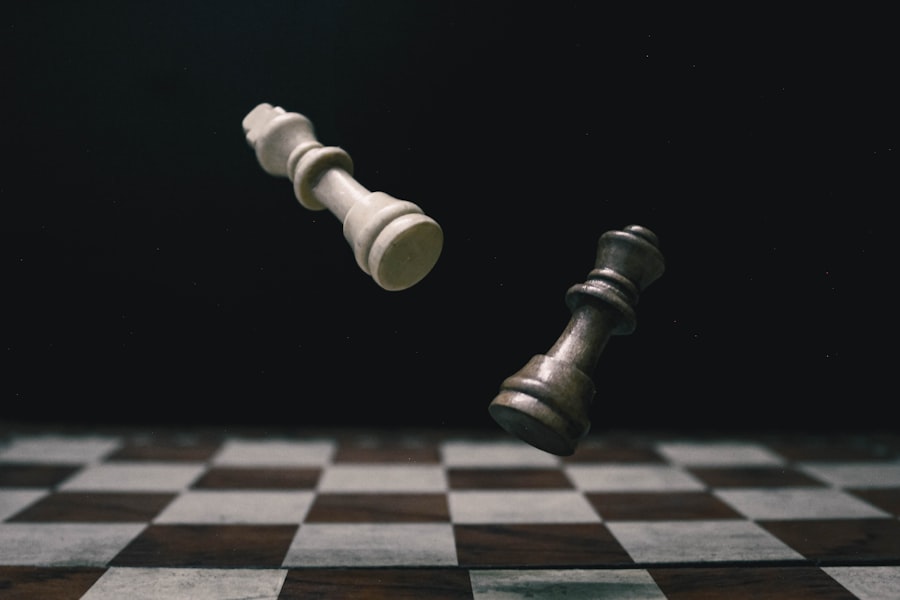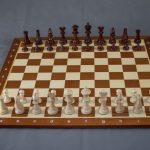Mastering Chess: Strategies for Success
Description
Chess is a two-player strategy board game that has captivated minds for centuries. At its core, the game is played on an 8×8 grid known as a chessboard, where each player commands an army of 16 pieces: one king, one queen, two rooks, two knights, two bishops, and eight pawns. Each piece has its own unique movement rules, which dictate how it can traverse the board.
The objective is to checkmate the opponent’s king, meaning the king is placed in a position where it cannot escape capture. This fundamental goal drives the entire game and shapes the strategies players employ. Understanding the basic rules and movements of each piece is essential for any aspiring chess player.
The king moves one square in any direction, while the queen can move any number of squares along a rank, file, or diagonal. Rooks move in straight lines along ranks and files, bishops traverse diagonals, and knights have a unique L-shaped movement that allows them to jump over other pieces. Pawns move forward one square but capture diagonally, and they have the special ability to advance two squares on their first move.
Familiarity with these movements lays the groundwork for more complex strategies and tactics that players will encounter as they progress in their chess journey.
Key Takeaways
- Understanding the basics of chess is crucial for beginners, including learning the movement of each piece and the objective of the game.
- Developing opening strategies is important for controlling the center of the board and setting the stage for the middle game.
- Mastering middle game tactics involves understanding key concepts such as pawn structure, piece activity, and creating threats.
- Utilizing endgame techniques is essential for converting an advantage into a win, including understanding pawn promotion and king activity.
- Improving decision making and calculation involves evaluating different options and predicting potential outcomes in a given position.
Developing Opening Strategies
Popular Opening Strategies
One popular opening strategy is the “Italian Game,” which begins with the moves 1.e4 e5 2.Nf3 Nc6 3.Bc4. This opening aims to control the center of the board and prepare for rapid development of pieces, while also eyeing potential weaknesses in the opponent’s position. Another effective opening strategy is the “Sicilian Defense,” which arises after the moves 1.e4 c5.
Key Characteristics of the Sicilian Defense
The Sicilian Defense is favored by many aggressive players because it allows Black to counterattack and create imbalances in the position. This defense leads to rich tactical possibilities and has been employed by numerous world champions.
Mastering Opening Strategies
Players must familiarize themselves with various openings and their underlying principles to choose the best approach for their style of play. Understanding the ideas behind these openings rather than merely memorizing moves can lead to more flexible and adaptive play.
Mastering Middle Game Tactics

The middle game is where chess truly comes alive, as players engage in complex tactical battles and strategic maneuvering. This phase typically begins once most pieces are developed and players start to formulate plans based on the position on the board. Tactics play a pivotal role during this stage, as they often determine the outcome of a game.
Common tactical motifs include forks, pins, skewers, discovered attacks, and double attacks. Recognizing these patterns can help players capitalize on their opponent’s mistakes or create threats that force them into a defensive posture. For instance, a fork occurs when a single piece attacks two or more of the opponent’s pieces simultaneously, often leading to material gain.
Knights are particularly adept at creating forks due to their unique movement capabilities. A classic example is when a knight can simultaneously attack a queen and a rook, forcing the opponent to choose which piece to save. Additionally, players should be aware of potential pins, where a piece cannot move without exposing a more valuable piece behind it to capture.
Mastering these tactical elements requires practice and keen observation, as players must constantly evaluate their own positions while anticipating their opponent’s threats.
Utilizing Endgame Techniques
| Endgame Technique | Definition | Example |
|---|---|---|
| Zugzwang | Forcing the opponent to make a disadvantageous move. | Forcing the opponent to move their king and lose control of a key square. |
| Opposition | Placing the kings directly opposite each other with an odd number of squares between them. | Using opposition to advance the king and gain space. |
| Triangulation | Wasting a move to put the opponent in a worse position. | Using triangulation to gain a tempo and improve the position of the pieces. |
The endgame is the final phase of a chess match, characterized by fewer pieces on the board and often requiring precise calculation and technique to convert advantages into victory. Understanding endgame principles is essential for players who wish to improve their overall game. Key concepts include king activity, pawn promotion, and piece coordination.
In many endgames, the king becomes an active piece that plays a crucial role in supporting pawns or attacking opposing pieces. One fundamental endgame technique is knowing how to convert a material advantage into a win. For example, if a player has an extra pawn in an endgame scenario, they should aim to promote that pawn into a queen while simultaneously preventing their opponent from doing the same.
This often involves using the king to escort the pawn forward while keeping an eye on opposing pieces that may threaten it. Additionally, players should familiarize themselves with common endgame positions such as king and pawn versus king or rook versus king and pawn scenarios. Mastery of these techniques can significantly enhance a player’s ability to close out games successfully.
Improving Decision Making and Calculation
Effective decision-making is at the heart of successful chess play. Players must constantly evaluate positions, weigh potential moves against one another, and anticipate their opponent’s responses. This process requires not only knowledge of tactics and strategies but also strong calculation skills.
Calculating variations involves envisioning several moves ahead and assessing the consequences of each potential action. The ability to accurately predict outcomes can be the difference between victory and defeat. To improve decision-making skills, players should practice analyzing positions without moving pieces on the board.
This mental exercise helps develop visualization skills and encourages deeper understanding of positional nuances. Additionally, players can benefit from solving tactical puzzles that challenge their calculation abilities. These puzzles often present scenarios where players must find the best move within a limited number of turns, honing their ability to think critically under pressure.
Regular practice in this area can lead to more confident decision-making during actual games.
Enhancing Positional Understanding

Key Factors in Positional Understanding
Key factors include pawn structure, piece activity, control of key squares, and open files for rooks. A solid grasp of these concepts allows players to formulate long-term plans that can lead to favorable outcomes.
The Importance of Pawn Structure
For example, pawn structure plays a vital role in determining how pieces can maneuver effectively. Isolated pawns can become weaknesses that opponents can target, while connected pawns can create powerful formations that support each other.
Developing an Intuitive Sense of Positional Play
Additionally, controlling open files with rooks can provide significant advantages in both attack and defense. Players should strive to develop an intuitive sense of positional play by studying classic games and analyzing how grandmasters navigate complex positions. This understanding will enable them to make more informed decisions throughout all phases of the game.
Studying Grandmaster Games
One of the most effective ways to improve at chess is by studying games played by grandmasters.
Analyzing grandmaster games allows individuals to see how top players approach various openings, middle game tactics, and endgame techniques in real-time scenarios.
For instance, one might examine how a grandmaster handles pawn structure or how they exploit weaknesses in their opponent’s position. Annotated games are particularly useful as they provide insights into the thought processes behind each move.
Many chess books and online resources offer collections of annotated grandmaster games that highlight key moments and decisions made during play. By immersing themselves in these high-level encounters, players can gain inspiration and deepen their understanding of advanced chess concepts.
Mental Preparation and Focus
Chess is as much a mental battle as it is a physical one; therefore, mental preparation plays a crucial role in achieving success on the board. Players must cultivate focus and concentration to navigate complex positions effectively while managing time constraints during competitive play. Developing mental resilience can help players maintain composure under pressure and recover from setbacks during games.
Techniques for enhancing mental preparation include visualization exercises that train the mind to picture positions without relying on physical boards or pieces. Mindfulness practices can also be beneficial in improving focus by teaching players how to remain present during games rather than becoming distracted by external factors or past mistakes. Additionally, establishing pre-game routines can help players enter a focused state before matches begin.
Whether through breathing exercises or visualization techniques, finding what works best for individual needs can significantly enhance performance during critical moments in chess games. In conclusion, mastering chess requires dedication across multiple dimensions—from understanding basic rules to developing advanced strategies and honing mental fortitude. Each phase of the game presents unique challenges that demand both tactical acumen and strategic foresight.
By immersing oneself in study and practice while remaining adaptable in decision-making processes, players can elevate their game and enjoy the rich complexities that chess has to offer.
If you’re a fan of strategy games like chess, you may also be interested in reading about the latest mobile gaming trends. Check out this article on the most viewed apps on freefiremax.mom to see what games are currently capturing the attention of players worldwide. Whether you’re looking for a new challenge or just want to stay up-to-date on the gaming scene, this article is sure to provide some valuable insights.
FAQs
What is chess?
Chess is a two-player strategy board game that is played on an 8×8 grid. It is one of the most popular and enduring games in the world, with a rich history dating back over 1500 years.
How is chess played?
Chess is played on a square board divided into 64 squares, with each player starting with 16 pieces: one king, one queen, two rooks, two knights, two bishops, and eight pawns. The objective of the game is to checkmate the opponent’s king, which means putting the king into a position where it cannot escape capture.
What are the basic rules of chess?
Each type of chess piece moves in a specific way: the king moves one square in any direction, the queen moves any number of squares in any direction, the rook moves any number of squares horizontally or vertically, the bishop moves any number of squares diagonally, the knight moves in an L-shape, and the pawn moves forward one square and captures diagonally. The game ends when a player’s king is in checkmate, or when a stalemate is reached.
What are the benefits of playing chess?
Chess has been shown to have numerous cognitive benefits, including improving memory, concentration, problem-solving skills, and strategic thinking. It is also a great way to improve patience and decision-making abilities.
What is the history of chess?
Chess originated in India around the 6th century and spread to Persia, where it became known as “shatranj.” It then spread to the Arab world and Europe, evolving into the modern game of chess that we know today. Chess has a rich and storied history, with many famous players and iconic matches throughout the centuries.





